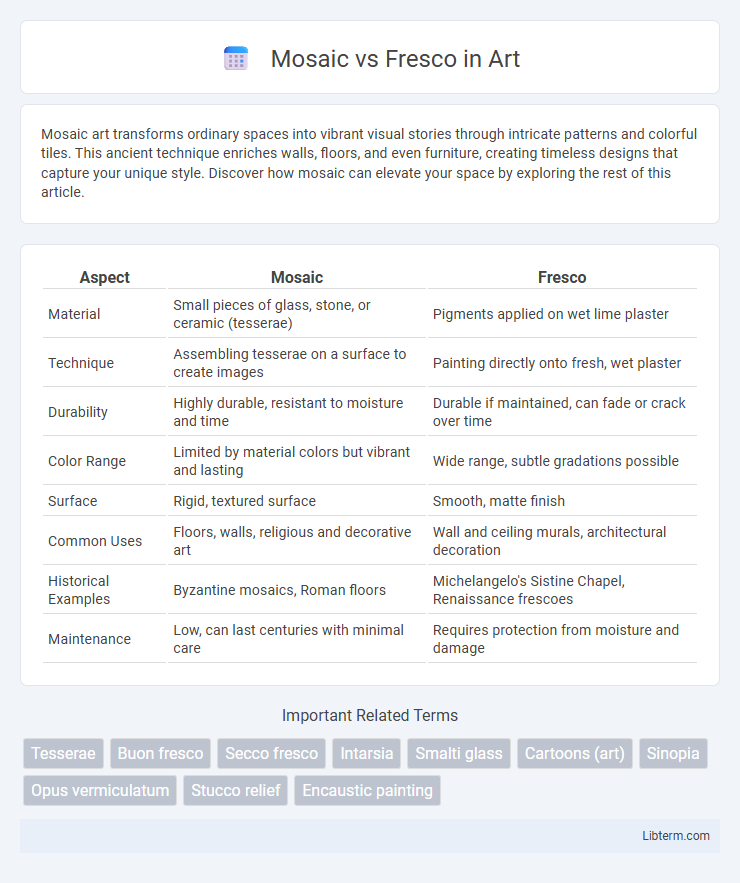Mosaic art transforms ordinary spaces into vibrant visual stories through intricate patterns and colorful tiles. This ancient technique enriches walls, floors, and even furniture, creating timeless designs that capture your unique style. Discover how mosaic can elevate your space by exploring the rest of this article.
Table of Comparison
| Aspect | Mosaic | Fresco |
|---|---|---|
| Material | Small pieces of glass, stone, or ceramic (tesserae) | Pigments applied on wet lime plaster |
| Technique | Assembling tesserae on a surface to create images | Painting directly onto fresh, wet plaster |
| Durability | Highly durable, resistant to moisture and time | Durable if maintained, can fade or crack over time |
| Color Range | Limited by material colors but vibrant and lasting | Wide range, subtle gradations possible |
| Surface | Rigid, textured surface | Smooth, matte finish |
| Common Uses | Floors, walls, religious and decorative art | Wall and ceiling murals, architectural decoration |
| Historical Examples | Byzantine mosaics, Roman floors | Michelangelo's Sistine Chapel, Renaissance frescoes |
| Maintenance | Low, can last centuries with minimal care | Requires protection from moisture and damage |
Introduction to Mosaic and Fresco
Mosaic is an ancient art form that uses small pieces of colored glass, stone, or other materials called tesserae to create detailed images or patterns, often seen in floors, walls, and ceilings. Fresco involves painting on freshly applied wet plaster, allowing pigments to merge with the wall surface for durable, vibrant murals typical in Renaissance art. Both techniques have distinct historical significance and are renowned for their unique methods of durability and visual impact in architectural decoration.
Defining Mosaic Art
Mosaic art is a decorative technique that assembles small pieces of colored glass, stone, or other materials called tesserae to create intricate patterns or images. This art form emphasizes durability and texture, often used in flooring, walls, and ceilings in historical and contemporary contexts. Unlike fresco, which is painted on wet plaster, mosaics rely on the meticulous placement of solid elements to produce vibrant, long-lasting visuals.
Understanding Fresco Painting
Fresco painting is a technique where pigments are applied onto freshly laid wet plaster, allowing the colors to become an integral part of the wall surface as it dries. This method ensures exceptional durability and vibrant hues, commonly seen in Renaissance and Roman art. Unlike mosaic, which assembles small pieces of glass or stone to create an image, fresco relies on chemical bonding between pigment and plaster for longevity and seamless visual flow.
Historical Backgrounds: Mosaic vs Fresco
Mosaic art originated in ancient Mesopotamia and flourished in Roman and Byzantine cultures, characterized by assembling small pieces of glass, stone, or ceramic called tesserae to create intricate images. Fresco painting, developed during the Italian Renaissance, involves applying water-based pigments onto freshly laid lime plaster, allowing the colors to become an integral part of the wall surface. Both techniques played significant roles in religious and architectural decoration, reflecting the cultural and technological advancements of their respective historical periods.
Key Materials and Techniques Used
Mosaic art primarily uses small pieces of glass, stone, or ceramic called tesserae, which are meticulously arranged on a durable surface with mortar or adhesive. Fresco technique involves applying natural pigments mixed with water directly onto freshly laid wet lime plaster, allowing the colors to chemically bond with the wall as it dries. Both methods demand precision, but mosaics emphasize assembling solid fragments, while frescoes rely on pigment absorption for color permanence.
Differences in Artistic Process
Mosaic art involves assembling small pieces of colored glass, stone, or other materials, known as tesserae, into intricate patterns or images by embedding them into a mortar base. Fresco painting requires applying pigment mixed with water directly onto freshly laid lime plaster, allowing the colors to chemically bond as the wall dries and creating a durable image. The key difference lies in mosaic's additive technique using physical materials versus fresco's subtractive, chemical process within a wet plaster surface.
Iconic Examples Around the World
Mosaic art is famously exemplified by the intricate Byzantine mosaics in Ravenna, Italy, such as those in the Basilica of San Vitale, showcasing vivid religious scenes using small colored tiles. Frescoes reach iconic status with Michelangelo's Sistine Chapel ceiling in Vatican City, where pigments were applied directly onto wet plaster to create dynamic biblical narratives. Both techniques represent monumental achievements in art history, with mosaics emphasizing durability and luminosity and frescoes highlighting fluidity and detail in large-scale storytelling.
Durability and Preservation Comparison
Mosaic art, composed of small pieces of stone, glass, or ceramic, exhibits exceptional durability due to its resistance to weathering and physical damage, enabling many ancient mosaics to remain intact for millennia. Frescoes, created by applying pigment onto wet plaster, are more susceptible to environmental factors such as moisture and temperature fluctuations, leading to potential fading and deterioration over time. Preservation efforts for mosaics often involve careful cleaning and protection from structural shifts, while frescoes require climate control and specialized restoration to prevent paint loss and plaster degradation.
Modern Applications and Influences
Mosaic art techniques continue to influence modern architectural facades, urban installations, and digital design due to their durability and vibrant visual impact. Fresco methods inspire contemporary muralists and interior designers who seek to create seamless, large-scale wall paintings with a timeless aesthetic. Both art forms shape modern applications by blending traditional craftsmanship with innovative materials and technology.
Choosing Between Mosaic and Fresco
Choosing between mosaic and fresco depends on the desired durability and visual texture; mosaics offer long-lasting, intricate designs using small pieces of glass or stone, making them ideal for outdoor or high-traffic areas. Frescoes involve painting on wet plaster, allowing pigments to become part of the wall surface, which creates vibrant, seamless art best suited for interior walls and ceilings. Consider environmental conditions and artistic intent when selecting between the tactile, three-dimensional quality of mosaics and the smooth, painterly style of frescoes.
Mosaic Infographic

 libterm.com
libterm.com